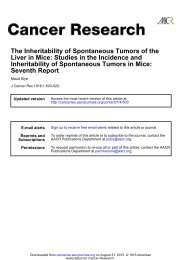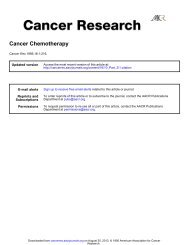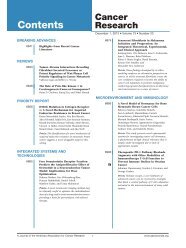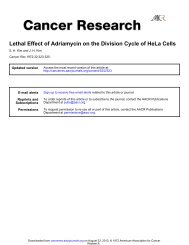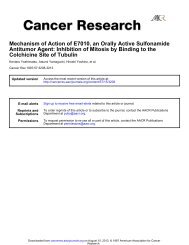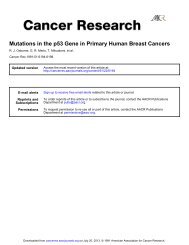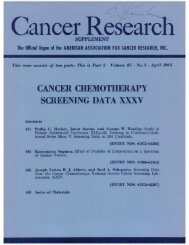XANTHOMA OF THE BREAST In a series of nine hundred (circa ...
XANTHOMA OF THE BREAST In a series of nine hundred (circa ...
XANTHOMA OF THE BREAST In a series of nine hundred (circa ...
You also want an ePaper? Increase the reach of your titles
YUMPU automatically turns print PDFs into web optimized ePapers that Google loves.
Xanthoma <strong>of</strong> the Breast<br />
Cushman D. Haagensen<br />
Am J Cancer 1932;16:1077-1103.<br />
Updated version<br />
Access the most recent version <strong>of</strong> this article at:<br />
http://cancerres.aacrjournals.org/content/16/5/1077<br />
E-mail alerts Sign up to receive free email-alerts related to this article or journal.<br />
Reprints and<br />
Subscriptions<br />
Permissions<br />
To order reprints <strong>of</strong> this article or to subscribe to the journal,<br />
contact the AACR Publications Department at pubs@aacr.org.<br />
To request permission to re-use all or part <strong>of</strong> this article, contact<br />
the AACR Publications Department at permissions@aacr.org.<br />
Downloaded from cancerres.aacrjournals.org on December 28, 2013. © 1932<br />
American Association for Cancer Research.
Downloaded from cancerres.aacrjournals.org on December 28, 2013. © 1932<br />
American Association for Cancer Research.<br />
<strong>XANTHOMA</strong> <strong>OF</strong> <strong>THE</strong> <strong>BREAST</strong><br />
CUSHMAN D. HAAGENSEN, M.D.<br />
(From the Memorial Hospital, New York)<br />
<strong>In</strong> a <strong>series</strong> <strong>of</strong> <strong>nine</strong> <strong>hundred</strong> (<strong>circa</strong>) tumors <strong>of</strong> the breast in which<br />
the preoperative diagnosis was carcinoma, histologic examination<br />
showed that in three instances the lesion was a xanthoma. Although<br />
the diagnostic error in reference to xanthoma was, therefore,<br />
small, the rarity <strong>of</strong> these tumors and their relation to abnormal<br />
lipoid metabolism prompts a discussion <strong>of</strong> them, as well as <strong>of</strong><br />
the xanthomatous degenerative processes occurring secondarily in<br />
inflammations and in true neoplasms in the breast.<br />
Xanthomas are apparently not true neoplasms. A neoplasm<br />
has been defined as a more or less circumscribed collection <strong>of</strong> cells<br />
arising wholly independently <strong>of</strong> the rest <strong>of</strong> the body, in general growing<br />
progressively, and serving no useful purpose in the organism.<br />
Xanthomas violate the second premise in the definition, for they<br />
have been shown by blood chemistry determinations to be related<br />
to an abnormal lipoid metabolism. Before the development <strong>of</strong><br />
the modern quantitative methods <strong>of</strong> blood chemistry which enabled<br />
this factor to be proved, there were well known clinical findings<br />
which suggested it. Xanthomas were known to be most frequent<br />
in elderly individuals with diseases <strong>of</strong> the liver, particularly those<br />
complicated by icterus, with nephritis, and with diabetes. Hutchinson,<br />
Sangster and Crocker, for instance, found that four-fifths<br />
<strong>of</strong> the 28 cases <strong>of</strong> xanthoma multiplex which they collected in 1882<br />
were associated with chronic jaundice. Torok made a similar<br />
report. Chauffard and Laroche in 1911 first made blood cholesterin<br />
determinations in cases <strong>of</strong> xanthoma and found the cholesterin<br />
content to be distinctly elevated. This finding has since<br />
been verified by many workers. It has even been shown that when<br />
the blood cholesterin falls as the result <strong>of</strong> the administration <strong>of</strong><br />
a cholesterin-free diet or because <strong>of</strong> treatment <strong>of</strong> coexisting diabetes,<br />
the xanthomas may disappear. Xanthomas are thus the local<br />
manifestation <strong>of</strong> a syndrome which may be called xanthomatosis.<br />
<strong>THE</strong> CLASSIFICATION <strong>OF</strong><br />
<strong>XANTHOMA</strong>S<br />
The term xanthoma covers such a variety <strong>of</strong> disease types that<br />
it would appear that the understanding <strong>of</strong> xanthomas <strong>of</strong> the breast<br />
1077
Downloaded from cancerres.aacrjournals.org on December 28, 2013. © 1932<br />
American Association for Cancer Research.<br />
1078 CUSHMAN D. HAAGENSEN<br />
would be facilitated by a brief survey and classification <strong>of</strong> the types<br />
<strong>of</strong> xanthoma in general. A division into two broad groups on the<br />
basis <strong>of</strong> whether the tumor is a primary xanthoma, made up wholly<br />
<strong>of</strong> xanthoma cells, arising as a local manifestation <strong>of</strong> the syndrome<br />
<strong>of</strong> xanthomatosis, or a secondary degenerative process in an inflammatory<br />
or neoplastic lesion, would seem to be the simplest classification.<br />
Such a classification closely follows those proposed by<br />
Siemens and by Asch<strong>of</strong>f. The terminology follows:<br />
A. Primary Xanthoma (Simple hematogenous cholesterosis, Sie<br />
. mens; Xanthoma, Asch<strong>of</strong>f): A tumor composed wholly <strong>of</strong><br />
xanthoma cells, and arising as a local manifestation <strong>of</strong> the<br />
syndrome <strong>of</strong> xanthomatosis.<br />
B. Secondary Xanthomatous Degeneration in (1) neoplasms and (2)<br />
inflammatory processes (<strong>In</strong>flammatory-degenerative cholesterosis,<br />
Siemens; Pseudoxanthoma, Asch<strong>of</strong>f).<br />
A. PRIMARY <strong>XANTHOMA</strong><br />
Most <strong>of</strong> the types <strong>of</strong> xanthoma can be grouped as subvarieties <strong>of</strong><br />
the syndrome <strong>of</strong> xanthomatosis. They will have in common a<br />
proved etiology <strong>of</strong> disturbed lipoid metabolism. They will have,<br />
also, a common histologic structure, the unit in which is the<br />
characteristic xanthoma or foam cell. This is a very large cell,<br />
measuring usually between 30 and 50 microns in diameter. It is<br />
<strong>of</strong>ten round but adapts its shape to the interstices in the connectivetissue<br />
stroma in which it lies. The nucleus is very small and round.<br />
The cytoplasm, which makes up most <strong>of</strong> the cell, stains lightly.<br />
Under high power its foamy appearance is seen to be due to a fine<br />
network in which droplets <strong>of</strong> cholesterin esters are contained.<br />
These tumors present no evidence <strong>of</strong> inflammatory origin in the<br />
form <strong>of</strong> lymphocytic, polynuclear or plasma-cell infiltration.<br />
They are not associated with other varieties <strong>of</strong> neoplasms. They<br />
contain occasional giant cells, which usually lie in the vicinity <strong>of</strong><br />
the crystals <strong>of</strong> cholesterin esters which are scattered throughout<br />
the tumor. These crystals, as well as the intracellular droplets,<br />
when studied in unstained sections after fixation in formalin, are<br />
doubly refractive to polarized light. The subvarieties <strong>of</strong> xanthoma<br />
included in this primary syndrome <strong>of</strong> xanthomatosis are as follows:<br />
(1) Xanthoma palpebrarum: This is the most frequent type <strong>of</strong><br />
xanthoma. It has been recognized and described by dermatologists<br />
for over a century. The characteristic plaques and nodules,
Downloaded from cancerres.aacrjournals.org on December 28, 2013. © 1932<br />
American Association for Cancer Research.<br />
<strong>XANTHOMA</strong> <strong>OF</strong> <strong>THE</strong> <strong>BREAST</strong> 1079<br />
citron-yellow to saffron or brown, are symmetrically situated<br />
on or about the eyelids. They develop slowly, usually in middle<br />
age or old age. and persist throughout life.<br />
(2) Xanthoma multiplex: Under this designation are grouped<br />
those less frequent cases with multiple xanthoma nodules situated<br />
most frequently on the scalp, knees, elbows, buttocks, or fingers.<br />
It is noteworthy that these regions are those most exposed to<br />
trauma. The mucous membranes, particularly the cornea and<br />
buccal mucosa, may also be involved. The distribution <strong>of</strong>ten<br />
follows the folds <strong>of</strong> the skin and is usually symmetrical. Autopsy<br />
in these cases may show xanthoma nodules in any <strong>of</strong> the viscera,<br />
but particularly in the liver, spleen, and meninges. <strong>In</strong> a considerable<br />
percentage <strong>of</strong> cases disease <strong>of</strong> the liver, such as cirrhosis or<br />
some type <strong>of</strong> toxic or infectious hepatitis, is found. Sikemeier<br />
collected a <strong>series</strong> <strong>of</strong> cases <strong>of</strong> this type and reported one in which<br />
the liver was the seat <strong>of</strong> localized tuberculosis.<br />
Most <strong>of</strong> the recently reported cases <strong>of</strong> xanthoma multiplex<br />
have included blood analyses, which showed an elevated blood<br />
cholesterin. Richter (Case 1) described a case <strong>of</strong> this type in<br />
which the blood cholesterin on admission was 650 mg. per cent.<br />
After the patient had been on a cholesterin-free diet for six weeks<br />
the blood cholesterin had fallen to 281 mg. per cent and the xanthoma<br />
nodules had become s<strong>of</strong>ter and smaller. Although the<br />
blood cholesterin has generally been found to be elevated, there are<br />
reports <strong>of</strong> isolated cases, such as those described by Siemens and by<br />
Rosenbloom, in which it remained within normal limits. Schmidt<br />
has emphasized that the hypercholesterinemia may be intermittent,<br />
and that repeated determinations are therefore necessary.<br />
Chalipsky and Veger have called attention to a group <strong>of</strong> cases<br />
in which xanthoma multiplex occurs in association with hypogenitalism<br />
and disturbed ovarian function. They describe one<br />
such case which they observed.<br />
<strong>In</strong> a small group <strong>of</strong> cases xanthoma seems to be familial. This<br />
type <strong>of</strong> the disease has the same anatomic distribution as xanthoma<br />
multiplex except that the eyelids do not seem to be involved. The<br />
lesions may be congenital or may appear at any time before<br />
puberty. There is no evidence <strong>of</strong> associated liver disease. Mackenzie<br />
and Startin described two families in each <strong>of</strong> which there<br />
were several members affected by the disease. Arning and Lippmann<br />
observed xanthomatosis in a mother and in five <strong>of</strong> her <strong>nine</strong><br />
children. Hufschmitt and Nessmann have recently reported a
Downloaded from cancerres.aacrjournals.org on December 28, 2013. © 1932<br />
American Association for Cancer Research.<br />
1080 CUSHMAN D. HAAGENSEN<br />
family in which three sisters had xanthoma nodules <strong>of</strong> the hands<br />
and feet and hypercholesterinemia. Schmidt has described a<br />
family in which all five <strong>of</strong>fspring <strong>of</strong> a healthy father and mother<br />
were affected. At one time or another all the children showed<br />
hypercholesterinemia.<br />
(3) Xanthoma diabeticorum: These rare cases may present<br />
generalized xanthomas involving the skin, mucous membranes,<br />
serous surfaces, liver, spleen, and many other viscera. Lubarsch<br />
reported a case in which the xanthomatosis was particularly<br />
prominent in the liver, lymph nodes, gums, bone marrow, and<br />
appendix. He believes that, in addition to the underlying hypercholesterinemia,<br />
a condition <strong>of</strong> lymphoid stasis is concerned in<br />
xanthomatosis. <strong>In</strong> such lymphoid stasis he sees the explanation<br />
for xanthomatosis being most prominent in the organs containing<br />
lymphoid tissue, as in his case. At autopsy <strong>of</strong> a woman dying<br />
with diabetes Petri found a massive xanthoma <strong>of</strong> the mesentery.<br />
<strong>In</strong> an attempt to identify the particular lipoids contained in the<br />
tumor, many staining reactions and methods <strong>of</strong> chemical analysis<br />
for different lipoids were employed. The most significant finding<br />
was a total cholesterin content ten times that <strong>of</strong> normal mesenteric<br />
tissue.<br />
Major studied three cases <strong>of</strong> xanthoma diabeticorum which<br />
showed an elevated blood cholesterin. Following suitable diabetic<br />
treatment the blood cholesterin fell to within normal limits and<br />
some <strong>of</strong> the xanthoma nodules disappeared. Richter, Wile,<br />
Eckstein, and Curtis, and also Ralli have described similar cases in<br />
which the xanthoma nodules regressed when the patient was put<br />
on a diabetic regime. Ralli's case was particulary noteworthy in<br />
that the patient had a pituitary tumor and acromegaly associated<br />
with true diabetes mellitus.<br />
(4) Christian's-Schiiller's Disease: <strong>In</strong> 1916 Schuller described<br />
the cases <strong>of</strong> two children with defects in the skull and exophthalmos.<br />
The elder, a boy aged sixteen, also showed dystrophia adiposogenitalis,<br />
and the younger, a girl aged four, had diabetes insipidus.<br />
<strong>In</strong> 1919 Christian reported the case <strong>of</strong> a child aged five with defects<br />
in the membranous bones, exophthalmos, and diabetes insipidus.<br />
Occasional cases presenting the features <strong>of</strong> this peculiar syndrome<br />
continued to be reported without any light being thrown on the<br />
pathogenesis <strong>of</strong> the disease. Several cases were autopsied, and<br />
yellowish or brownish growths eroding the base <strong>of</strong> the skull and in<br />
other viscera were found; they were interpreted as inflammatory or
Downloaded from cancerres.aacrjournals.org on December 28, 2013. © 1932<br />
American Association for Cancer Research.<br />
<strong>XANTHOMA</strong> <strong>OF</strong> <strong>THE</strong> <strong>BREAST</strong> 1081<br />
tuberculous. Weidman and Freeman autopsied a case (Case 2)<br />
which in addition to the typical features <strong>of</strong> the disease showed<br />
hypercholesterinemia. They did not recognize, however, that it<br />
was a case <strong>of</strong> Christian's-SchUller's disease and regarded the<br />
xanthomatous character <strong>of</strong> the lesions as secondary to chronic<br />
inflammation.<br />
<strong>In</strong> 1928 Rowland described two cases, from the study <strong>of</strong> which<br />
he was able to show that the disease is a form <strong>of</strong> generalized<br />
xanthomatosis dependent upon an underlying hypercholesterinemia.<br />
<strong>In</strong> addition to the triad <strong>of</strong> symptoms mentioned above,<br />
Rowland's patients showed loose teeth, chronic otorrhea, dwarfism.<br />
and dystrophia adiposogenitalis. <strong>In</strong> the case in which the blood<br />
cholesterin was determined it was found to be elevated. The<br />
other case came to autopsy. The base <strong>of</strong> the skull was found to be<br />
extensively eroded and the sella turcica destroyed by yellowish<br />
tissue made up <strong>of</strong> typical xanthoma cells. The ilium contained a<br />
similar tumor. <strong>In</strong> addition there was lipoidosis <strong>of</strong> the interstitial<br />
cells <strong>of</strong> many organs, including the thyroid lymph nodes, kidneys,<br />
liver, lungs, heart, and bone marrow. Rowland found reports <strong>of</strong><br />
sixteen other cases. <strong>In</strong> two-thirds <strong>of</strong> these the onset <strong>of</strong> the disease<br />
was during the second year <strong>of</strong> life.<br />
Chiari has recently reported a typical case <strong>of</strong> Christian's<br />
Schuller's disease in a man aged twenty-<strong>nine</strong>. This is the oldest<br />
patient on record. Chiari's pathologic study <strong>of</strong> this case is, moreover,<br />
the most complete yet made in this rare disease. He has<br />
found reports <strong>of</strong> 21 other cases.<br />
(5) Solitary Xanthomas: This group includes the solitary,<br />
tumor-like xanthomas which may occur in.almost any part <strong>of</strong> the<br />
body. They have been called xanthosarcomas by the English<br />
and Germans, and xanthomes en tumeurs by the French. Although<br />
rare, they apparently constitute a distinct type <strong>of</strong> primary xanthoma<br />
belonging to the syndrome <strong>of</strong> xanthomatosis. They are<br />
entirely made up <strong>of</strong> xanthoma cells and show no evidence <strong>of</strong><br />
degeneration nor any leukocytic or plasma-cell infiltration indicative<br />
<strong>of</strong> a chronic inflammatory process. Pick and Pinkus described<br />
tumors <strong>of</strong> the tongue, parotid, and vulva which fall into this class.<br />
Hutter reported a very large solitary xanthoma arising from the<br />
skin over the sternum which was accompanied by hypercholesterinemia.<br />
The writer has observed this type <strong>of</strong> tumor in the tongue.<br />
The xanthoma cells formed tumor-like groups <strong>of</strong> cells and infiltrated<br />
the surrounding muscle, which appeared to be normal.
Downloaded from cancerres.aacrjournals.org on December 28, 2013. © 1932<br />
American Association for Cancer Research.<br />
1082 CUSHMAN D. HAAGENSEN<br />
B. SECONDARY <strong>XANTHOMA</strong>TOUS DEGENERATION<br />
(1) Secondary Xanthomatous Degeneration in True Neoplasms:<br />
Much confusion has arisen in the classification <strong>of</strong> xanthomas because<br />
<strong>of</strong> the fact that various types <strong>of</strong> true neoplasms showing<br />
xanthomatous degeneration have been improperly designated by<br />
some writers as xanthosarcomas or xanthomas, thus failing to distinguish<br />
them from primary xanthomas occurring in the syndrome<br />
<strong>of</strong> xanthomatosis, which have been discussed above. The fundamental<br />
distinction between the two groups is made upon their<br />
histologic structure. Primary xanthomas are made up entirely <strong>of</strong><br />
xanthoma cells. On the other hand, the true neoplasms showing<br />
xanthomatous degeneration, as their name would indicate, contain<br />
not only xanthoma cells but also the epithelial or other type <strong>of</strong> cell<br />
characterizing the neoplasm. As Borst has emphasized, these<br />
tumors should not be called xanthomas, but should be designated<br />
as xanthomatous carcinomas, etc., according to the true nature<br />
<strong>of</strong> the particular neoplasm in question.<br />
Such xanthomatous degeneration is seen in a wide variety <strong>of</strong><br />
neoplasms. It occurs in neur<strong>of</strong>ibromas, and it is not uncommon<br />
in neurogenic sarcomas. Epithelial tumors <strong>of</strong> different types<br />
show it. Dubs, for instance, described two cases <strong>of</strong> xanthomatous<br />
adenocarcinoma <strong>of</strong> the fundus <strong>of</strong> the uterus. Petri reported a<br />
xanthomatous adenocarcinoma <strong>of</strong> the stomach. Corten described<br />
a xanthomatous epithelioma <strong>of</strong> sebaceous gland origin developing<br />
in the thigh. Dietrich reported a retroperitoneal sarcoma which<br />
was xanthomatous, and Wessen a similar retropleural tumor.<br />
Ovarian cysts very <strong>of</strong>ten show xanthomatous degeneration.<br />
Xanthomatous degeneration usually occurs in a poorly nourished,<br />
frequently central portion <strong>of</strong> a tumor. The necrotic tumor<br />
cells are replaced by foam cells which, as far as cell morphology<br />
is concerned, resemble the xanthoma cells which occur in primary<br />
xanthomas. The lipoid which they contain is also usually <strong>of</strong> the<br />
same double-refracting type as that found in primary xanthoma.<br />
That this is not always the case, however, was shown by Petri,<br />
who found only neutral fat in the tumor which she reported. It<br />
is important to note that Mallory considers these xanthoma or<br />
foam cells which occur as a secondary degenerative phenomena in<br />
true neoplasms, and in granulomas, to be fatty endothelialleukocytes.<br />
He regards the double-refracting cholesterin content <strong>of</strong><br />
these cells, as well as the rhomboid cholesterin crystals sometimes<br />
occurring with them, as being the product <strong>of</strong> fatty degeneration
Downloaded from cancerres.aacrjournals.org on December 28, 2013. © 1932<br />
American Association for Cancer Research.<br />
<strong>XANTHOMA</strong> <strong>OF</strong> <strong>THE</strong> <strong>BREAST</strong> 1083<br />
and necrosis <strong>of</strong> cells. Whether secondary xanthomatous degeneration<br />
in neoplasms is correlated with hypercholesterinemia has<br />
not been determined. Blood cholesterin determinations have<br />
been done in only a few <strong>of</strong> these cases. <strong>In</strong> the two cases <strong>of</strong> xanthomatous<br />
carcinoma reported by Dubs there was no hypercholesterinemia.<br />
Because <strong>of</strong> their comparative frequency, and because their<br />
questionable nature has led to a confusing terminology, the<br />
giant-cell tumors showing xanthomatous degeneration which occur<br />
in the aponeuroses, tendon sheaths, and joint capsules <strong>of</strong> the extremities<br />
deserve to be considered as a separate group. These<br />
tumors have been designated by a great variety <strong>of</strong> names, including<br />
giant-cell sarcoma, xanthoma, xanthosarcoma, myeloxanthoma,<br />
myeloma, fibroma, granuloma, and endothelioma.<br />
They are the most frequently seen <strong>of</strong> all the varieties <strong>of</strong> tumor<br />
which contain foam cells. Growing slowly over a period <strong>of</strong> years,<br />
and perfectly benign, they form a distinct type <strong>of</strong> tumor. They<br />
are characterized in the gross by their encapsulation and, depending<br />
upon the extent to which xanthomatous degeneration has gone,<br />
by their yellow or brown color. Histologically they consist <strong>of</strong><br />
spindle or polyhedral cells which some authors regard as endothelial,<br />
giant cells <strong>of</strong> the foreign body type, foam cells, lymphocytes,<br />
and a connective tissue stroma, which may be very dense.<br />
Cholesterin crystals and hemosiderin pigment may be prominent.<br />
The structure varies a great deal. Some tumors are cellular and<br />
made up entirely <strong>of</strong> the spindle or polyhedral cells. <strong>In</strong> others the<br />
giant cells predominate. <strong>In</strong> many the xanthomatous degeneration<br />
has progressed to such a degree that the tumor is almost wholly<br />
made up <strong>of</strong> foam cells. Unfortunately these giant-cell tumors<br />
showing xanthomatous degeneration have come to be regarded<br />
as a separate group and are <strong>of</strong>ten improperly designated as xanthomas<br />
or xanthosarcomas. <strong>In</strong> reality they are but a variation <strong>of</strong> the<br />
banal giant-cell tendon sheath tumor.<br />
Weil, Landois and Reid, Broders, and Garrett have reported<br />
<strong>series</strong> <strong>of</strong> cases <strong>of</strong> these xanthomatous giant-cell tumors. Kirch<br />
was the first to appreciate, however, that they are not true xanthomas<br />
but simply neoplasms in which secondary xanthomatous<br />
degeneration has occurred. <strong>In</strong> his opinion any type <strong>of</strong> cell may<br />
be transformed into a foam cell by the deposition <strong>of</strong> cholesterin.<br />
Kirch made blood cholesterin determinations in seven patients<br />
with tumors <strong>of</strong> this type and found an elevated cholesterin in
Downloaded from cancerres.aacrjournals.org on December 28, 2013. © 1932<br />
American Association for Cancer Research.<br />
1084 CUSHMAN D. HAAGENSEN<br />
every instance. He therefore concluded that in secondary<br />
xanthomatous degeneration in true neoplasms, just as with primary<br />
xanthomas, there is an underlying hypercholesterinemia,<br />
Fleissig, and more recently Seyler, have preferred to classify<br />
these giant-cell tumors <strong>of</strong> tendon sheaths as granulomas.<br />
(2) Secondary Xanthomatous Degeneration in Chronic <strong>In</strong>flammatory<br />
Processes: <strong>In</strong> a great variety <strong>of</strong> chronic inflammatory processes<br />
the same type <strong>of</strong> xanthomatous degeneration occurs as has<br />
just been described in neoplasms. The foam cells appear scattered<br />
among the lymphocytes, plasma cells, and polynuclears which<br />
characterize the lesion. Such xanthomatous degeneration is<br />
particularly common in chronic salpingitis, and in the walls <strong>of</strong> old<br />
abscesses. It has been reported in abdominal scars, at the site<br />
<strong>of</strong> arsenic injections, in pock-marks, in the scars <strong>of</strong> herpes zoster,<br />
and at the sites <strong>of</strong> previous chronic skin affections <strong>of</strong> various types.<br />
There are no available reports <strong>of</strong> blood cholesterin determinations<br />
in lesions <strong>of</strong> this type.<br />
<strong>XANTHOMA</strong> <strong>OF</strong> <strong>THE</strong> BREABT<br />
Tumors <strong>of</strong> the breast containing xanthoma cells may be discussed<br />
on the basis <strong>of</strong> the classification outlined above for xanthomas<br />
in general.<br />
A. Primary Xanthoma <strong>of</strong> the Breast<br />
The localization <strong>of</strong> solitary xanthoma in the breast as part <strong>of</strong><br />
the syndrome <strong>of</strong> xanthomatosis must be exceedingly rare. A<br />
search <strong>of</strong> the medical literature reveals only one case report <strong>of</strong> the<br />
condition. Cheatle described a circumscribed but not encapsulated<br />
xanthoma which he removed from the breast <strong>of</strong> a woman<br />
aged thirty-eight. Blood cholesterin determinations were not<br />
done.<br />
The following three cases are examples <strong>of</strong> this type <strong>of</strong> tumor<br />
observed at the Memorial Hospital in a <strong>series</strong> <strong>of</strong> 900 (<strong>circa</strong>) tumors<br />
<strong>of</strong> the breast in which the preoperative diagnosis was carcinoma.<br />
<strong>In</strong> one <strong>of</strong> these cases the breast was removed, and only when the<br />
histologic sections were studied did the diagnosis <strong>of</strong> xanthoma<br />
become apparent. <strong>In</strong> the two other cases a local excision <strong>of</strong> the<br />
tumor was done and a diagnosis <strong>of</strong> xanthoma made from the<br />
yellow color <strong>of</strong> the gross specimen.<br />
CASE 1: C. B. T., an unmarried Irish woman, aged seventy-four, was<br />
referred to Dr. James Duffy at the Memorial Hospital for treatment on<br />
Aug. 17, 1930.
Downloaded from cancerres.aacrjournals.org on December 28, 2013. © 1932<br />
American Association for Cancer Research.<br />
<strong>XANTHOMA</strong> <strong>OF</strong> <strong>THE</strong> <strong>BREAST</strong> 1085<br />
Past History: There was no history <strong>of</strong> cancer in her family to her<br />
knowledge. She had never been ill except for a fractured knee many<br />
years ago. She had lost 21 pounds within recent years, having formerly<br />
weighed 170, now 149.<br />
Present Illness: Five years previously, about 1925, she had first observed<br />
a small lump in the upper inner portion <strong>of</strong> the left breast. It had<br />
grown very slowly to attain its present bulk. It had been painless. The<br />
patient had no cough or bone pains.<br />
Physical Examination: The patient was a fairly well nourished, elderly<br />
woman. Most <strong>of</strong> her fat was abdominal. Scattered over her skin, most<br />
prominent on the abdomen and face, were many brown to black macular<br />
and papular lesions which resembled senile keratoses. The heart and<br />
lungs were not remarkable. The blood pressure was 165 systolic and 70<br />
diastolic.<br />
FIGS. 1 AND 2. CASE 1: PRIMARY <strong>XANTHOMA</strong> <strong>OF</strong> <strong>BREAST</strong>, BE~'ORE (LE~'T) AND AFTER<br />
RADIATION<br />
Occupying the upper inner quadrant <strong>of</strong> the right breast was a tumor<br />
(Fig. 1) measuring 9 em. in diameter and elevated 4 em. above the surface<br />
<strong>of</strong> the breast. The skin over it was reddened and shiny. The middle<br />
<strong>of</strong> the tumor was s<strong>of</strong>t--suggesting a central area <strong>of</strong> necrosis. It was<br />
slightly movable over deeper structures. The nipple was not retracted.<br />
There were no nodes palpable in the right axilla or supraclavicular space.<br />
<strong>In</strong> the left axilla several small, s<strong>of</strong>t nodes were felt.<br />
Repeated urine examination frequently showed a trace <strong>of</strong> albumin<br />
and occasional granular casts. Blood urea nitrogen was 12.1 mg. <strong>In</strong><br />
addition the urine regularly contained sugar-as much as 2 per cent.<br />
Blood sugar on admission was 166 mg. Roentgenograms <strong>of</strong> the chest<br />
were negative.<br />
A diagnosis <strong>of</strong> adenocarcinoma <strong>of</strong> the breast with impending ulceration,<br />
and chronic nephritis and diabetes was made.
Downloaded from cancerres.aacrjournals.org on December 28, 2013. © 1932<br />
American Association for Cancer Research.<br />
FIGs. 3 AND 4. CASE 1: PRIMARY <strong>XANTHOMA</strong> <strong>OF</strong> <strong>THE</strong> <strong>BREAST</strong>. X 100 AND X 3DO<br />
1086
FlU. 5. CASE 1: XANTIIOM.\ C~;LLS CONTAINING CHOLESTERIN ESTER DHOI'LETS<br />
SUDAN III, COl;NTEHSTAINED WITH HEMATOXYLIN<br />
Downloaded from cancerres.aacrjournals.org on December 28, 2013. © 1932<br />
American Association for Cancer Research.
Downloaded from cancerres.aacrjournals.org on December 28, 2013. © 1932<br />
American Association for Cancer Research.
Downloaded from cancerres.aacrjournals.org on December 28, 2013. © 1932<br />
American Association for Cancer Research.<br />
<strong>XANTHOMA</strong> <strong>OF</strong> <strong>THE</strong> <strong>BREAST</strong> 1087<br />
Treatment: The patient was seen in consultation by Sir Lenthal<br />
Cheatle, who advised interstitial radiation. Accordingly, on Aug. 26,<br />
1930, and during the following days, six needles containing a total <strong>of</strong> 85<br />
millicuries <strong>of</strong> radon filtered by 0.3 mm. <strong>of</strong> gold and 0.2 mm. <strong>of</strong> steel were<br />
inserted into 18 sites about the periphery <strong>of</strong> the tumor and allowed to<br />
remain in situ until a total <strong>of</strong> 7,200 milicurie hours had been delivered to<br />
the tumor.<br />
Ten weeks later, Nov. 5, 1930, there was a marked decrease in the size<br />
<strong>of</strong> the tumor. A reaction, limited to reddening and slight desquamation<br />
<strong>of</strong> the overlying skin, had occurred. The central area <strong>of</strong> s<strong>of</strong>tening was<br />
less marked.<br />
By March 12, 1931, seven months after the radiation had been completed,<br />
the contour <strong>of</strong> the breast was almost normal (Fig. 2). The reddish<br />
discoloration <strong>of</strong> the skin had completely disappeared, only slight<br />
post-radiation pigmentation remaining. Of the tumor, only an indefinite<br />
area somewhat more firm than normal mammary tissue remained. Because<br />
it was felt that, although there had been remarkable regression,<br />
a residuum <strong>of</strong> the tumor persisted, a local mastectomy was decided upon.<br />
The diabetes had responded readily to a dietary regime and was not considered<br />
a contraindication. On June 4, 1931, the operation was done,<br />
novocaine infiltration anesthesia being used. Recovery was uneventful.<br />
On discharge the patient was cautioned to continue her dietary<br />
regime. A year later (June 10, 1932) there had been no recurrence <strong>of</strong><br />
the tumor. At that time her blood sugar was 143 mg. The blood<br />
cholesterin was 175 mg., that is within the upper limits <strong>of</strong> normal. It<br />
may, <strong>of</strong> course, be objected that had a blood cholesterin determination<br />
been made at the time the tumor was treated, a year previously, and<br />
before the institution <strong>of</strong> a restricted diet, hypercholesterinemia might<br />
have been found. Kirch, however, in his <strong>series</strong> <strong>of</strong> xanthomatous tumors,<br />
found hypercholesterinemia persisting as late as ten years after operation.<br />
Gross Diagnosis (Pathologic Specimen No. C 4119): A simple mastectomy<br />
has been done. Four centimeters from the nipple there is an<br />
encapsulated, centrally necrotic tumor measuring 6 x 4 x 6 em. Its cut<br />
surface is s<strong>of</strong>t, reddish, and granular, suggesting bulky adenocarcinoma.<br />
Microscopic Diagnosis: The tumor is composed wholly <strong>of</strong> very large<br />
xanthoma cells lying in the interstices <strong>of</strong> a prominent fibrous stroma<br />
(Figs. 3 and 4). The xanthoma cells are round when they lie free and<br />
polyhedral when they lie among the strands <strong>of</strong> fibrous stroma. They<br />
vary between 30 and 50 microns in diameter. The nuclei are comparatively<br />
very small, stain darkly, and are <strong>of</strong>ten eccentrically situated. The<br />
cytoplasm, which makes up the great bulk <strong>of</strong> the cell, is acidophile and<br />
has the characteristic foamy appearance. With higher magnification<br />
this is seen to be due to the presence <strong>of</strong> a fine network in the cytoplasm.<br />
Stained with Sudan III (Fig. 5) this network is seen to contain orangered<br />
cholesterin ester droplets. A few crystals (Fig. 6) surrounded by giant<br />
cells <strong>of</strong> the foreign-body type are seen. Large areas <strong>of</strong> the tumor are<br />
necrotic. The tumor contains no lymphocytic, plasma-cell, or polymorphonuclear<br />
infiltration. No neoplastic elements are seen. The vascular<br />
supply is poor.
Downloaded from cancerres.aacrjournals.org on December 28, 2013. © 1932<br />
American Association for Cancer Research.<br />
1088 CUSHMAN D. HAAGENSEN<br />
Studied with the polarizing microscope, formalin fixed and unstained<br />
sections show the intercellular droplets and the crystals to be doubly<br />
refracting.<br />
Diagnosis: Primary xanthoma <strong>of</strong> the breast.<br />
FIG. 6.<br />
CASE 1: CHOLESTERIN ESTER CRYSTALS SURROUNDED BY FOREIGN-BODY GIANT<br />
CELLS IN <strong>XANTHOMA</strong> <strong>OF</strong> <strong>BREAST</strong><br />
CASE 2: A. M., a married American woman, aged forty-one, came<br />
to the Memorial Hospital on Dr. Douglas Quick's service, April 1, 1928.<br />
Past History: The patient had never been pregnant. She had occasionally<br />
had slight pain in her breasts with menstruation.<br />
Present Illness: The lump in the left breast was first noticed one<br />
month previously. The patient could not recall any trauma to the<br />
breast.<br />
Physical Examination: The patient was a poorly nourished woman.<br />
<strong>In</strong> the inner lower quadrant <strong>of</strong> the left breast was a discrete, firm, freely<br />
movable tumor about 1 em. in diameter. There was no skin adherence,<br />
or nipple retraction. <strong>In</strong> both axillae were enlarged but s<strong>of</strong>t nodes.<br />
Roentgenograms <strong>of</strong> the chest were negative. The urine contained a trace<br />
<strong>of</strong> albumin, and many hyaline casts were seen. Its specific gravity was<br />
1.030.<br />
Treatment: A diagnosis <strong>of</strong> probable chronic mastitis was made, but<br />
to exclude carcinoma it was decided to excise the tumor. Preoperative<br />
roentgen radiation was given over the tumor in April, and during the
Downloaded from cancerres.aacrjournals.org on December 28, 2013. © 1932<br />
American Association for Cancer Research.<br />
FIGs. 7 AND 8. CASE 2: PIUMARY <strong>XANTHOMA</strong> <strong>OF</strong> <strong>BREAST</strong>. X 100 AND X 400<br />
99 1089
Downloaded from cancerres.aacrjournals.org on December 28, 2013. © 1932<br />
American Association for Cancer Research.<br />
1090 CUSHMAN D. HAAGENSEN<br />
following month it diminished distinctly in size. <strong>In</strong> May 1928 excision<br />
was done. Three years later there had been no recurrence.<br />
Gross Diagnosis (Pathologic Specimen No. B 4810); The specimen<br />
consists <strong>of</strong> a wedge <strong>of</strong> breast tissue in which there is a well circumscribed<br />
yellowish nodule 0.5 ern. in diameter. Gross diagnosis: Xanthoma.<br />
Microscopic Diagnosis: The tumor is made up <strong>of</strong> xanthoma cells lying<br />
in a fibrous stroma (Figs. 7 and 8). The cells are between 20 and 40<br />
microns in diameter. The nuclei are relatively small. The foamy cytoplasm<br />
stains very lightly. Scattered foci <strong>of</strong> lymphocytes are seen.<br />
Diagnosis: Primary xanthoma <strong>of</strong> the breast.<br />
CASE 3: M. H. L., an Irish widow, aged thirty-eight, came to the<br />
Memorial Hospital, Nov. 10, 1926.<br />
Past History: One sister had had a tumor <strong>of</strong> the breast. The patient<br />
had had three normal pregnancies and had nursed all three children.<br />
The last lactation was in 1921.<br />
Present Illness: <strong>In</strong> March 1925, the patient had noticed a lump in<br />
her left breast, and in August 1926 a radical mastectomy was done in a<br />
New York hospital. <strong>In</strong> November 1926 she came to Memorial Hospital<br />
complaining <strong>of</strong> dyspnea.<br />
Phusical Examination: Examination showed a group <strong>of</strong> hard nodes<br />
in the left supraclavicular region. Roentgenograms <strong>of</strong> the chest were<br />
negative. The scar showed no evidence <strong>of</strong> recurrence.<br />
Treatment: A diagnosis <strong>of</strong> carcinoma metastasis was made and treatment<br />
with the radium element pack was given over the supraclavicular<br />
nodes.<br />
<strong>In</strong> January 1927 a freely movable, hard subcutaneous nodule about<br />
1 cm. in diameter was observed near the edge <strong>of</strong> the scar, in the anterior<br />
axillary line over the 9th costal cartilage. This was thought to be a<br />
recurrence <strong>of</strong> carcinoma and was excised under novocaine anesthesia.<br />
At this time the patient was fairly well nourished, although she was<br />
anemic. Several urine examinations were negative for sugar and albumin.<br />
<strong>In</strong> March 1927 the patient began to have pain in the back. Roentgenograms<br />
taken in April showed widespread metastases in the lumbar<br />
spine, pelvic bones, and upper femora. Death occurred in October<br />
1927.<br />
Gross Diagnosis (Pathologic Specimen No. B 1497): On section <strong>of</strong> the<br />
nodule excised from the chest wall a small, yellowish, solid, opaque nodule<br />
2 mm. in diameter is seen. It is not adherent to the skin but rests on<br />
the fascia and is freely movable. Gross diagnosis; Xanthoma.<br />
Microscopic Diagnosis: The tumor is a small nodule, surrounded by<br />
fat, and composed wholly <strong>of</strong> xanthoma cells lying in a fibrous stroma<br />
(Figs. 9 and 10). The cells average 40 microns in diameter and are<br />
irregularly polyhedral in shape. The nuclei are comparatively small, and<br />
stain darkly. The cytoplasm is amphophilic and contains a fine fibrillar<br />
network. There is no lymphocytic infiltration. Carcinoma cells are not<br />
seen.<br />
Diagnosis: Primary xanthoma <strong>of</strong> chest wall at site <strong>of</strong> amputated<br />
breast.
Downloaded from cancerres.aacrjournals.org on December 28, 2013. © 1932<br />
American Association for Cancer Research.<br />
FIGs. 9 AND 10.<br />
CASE 3: PRIMARY <strong>XANTHOMA</strong> <strong>OF</strong> CHEST WALL AT SITE <strong>OF</strong> AMpUTATED<br />
<strong>BREAST</strong>. X 100 AND X 400<br />
1091
Downloaded from cancerres.aacrjournals.org on December 28, 2013. © 1932<br />
American Association for Cancer Research.<br />
1092 CUSHMAN D. HAAGENSEN<br />
COMMENT: These three cases <strong>of</strong> xanthoma are presumably<br />
examples <strong>of</strong> the solitary tumor-like type <strong>of</strong> primary xanthoma<br />
occurring in the syndrome <strong>of</strong> xanthomatosis. <strong>In</strong> the first patient<br />
the presence <strong>of</strong> diabetes as well as nephritis suggests a disturbed<br />
cholesterin metabolism. The blood cholesterin was found to be<br />
within normal limits when it was determined a year after operation.<br />
The second patient had nephritis, a frequent cause <strong>of</strong> xanthoma.<br />
<strong>In</strong> the third patient there was no apparent correlation between the<br />
supraclavicular and bone carcinoma metastases and the finding <strong>of</strong> a<br />
pure xanthoma in the subcutaneous tissue <strong>of</strong> the chest wall at the<br />
site <strong>of</strong> the amputated breast.<br />
B. Secondary Xanthomatous Degeneration in the Breast<br />
(1) Secondary Xanthomatous Degeneration in True Neoplasms oj<br />
the Breast: Groups <strong>of</strong> foam cells are not infrequently seen in fibroadenomas<br />
and carcinomas <strong>of</strong> the breast. They occur as a degenerative<br />
phenomenon in the poorly nourished or necrotic portions<br />
<strong>of</strong> these tumors. The fact that the breast is a fatty organ, and in<br />
addition secretes fat-containing milk which may be inspissated,<br />
may favor such xanthomatous degeneration in neoplasms <strong>of</strong> the<br />
breast. <strong>In</strong>' any event it is a common finding. Lobeck has made<br />
the most complete study <strong>of</strong> the subject. <strong>In</strong> 118 amputated breasts<br />
he found secondary xanthomatous degeneration sixteen times in<br />
carcinoma and once in a fibro-adenoma. He did blood cholesterin<br />
determinations in thirteen <strong>of</strong> these patients and found what he<br />
considered an abnormally high blood cholesterin in every instance.<br />
Gross described a large fibro-adenoma <strong>of</strong> the breast showing<br />
secondary xanthomatous degeneration. The patient's blood cholesterin<br />
was markedly elevated (400 mg.), Hedinger and Miller<br />
have also reported xanthomatous fibro-adenomas.<br />
No attempt will be made to report all the instances <strong>of</strong> breast<br />
neoplasms showing secondary xanthomatous degeneration in the<br />
records <strong>of</strong> the Memorial Hospital. The condition is too inconsequential<br />
to warrant such attention. The following is an illustrative<br />
case <strong>of</strong> secondary xanthomatous degeneration occurring in<br />
a giant intracanalicular fibro-adenoma.<br />
CASE 4: D. K., a married American woman, aged fifty-six, came to<br />
the Memorial Hospital, Dec. 23, 1928.<br />
Past History: She had had seven normal pregnancies and had nursed<br />
all seven children for more than two years without. any difficulty with<br />
her breasts. The last lactation had been twenty-six years before.
Downloaded from cancerres.aacrjournals.org on December 28, 2013. © 1932<br />
American Association for Cancer Research.<br />
FIGs. 11 AND 12. CASE 4: FlORO-ADENOMA <strong>OF</strong> <strong>BREAST</strong> SHOWING SECONDARY<br />
<strong>XANTHOMA</strong>TOUS DEGENERATION. X 100 AND X 400<br />
1093
Downloaded from cancerres.aacrjournals.org on December 28, 2013. © 1932<br />
American Association for Cancer Research.<br />
1094 CUSHMAN D. HAAGENSEN<br />
Present Illness: Thirty-seven years previously, while she was nursing<br />
her first baby, the patient had noticed a lump within the right nipple.<br />
About one year before admission she noticed that the whole right breast<br />
was enlarged. For one month there had been intermittent bleeding from<br />
the right nipple.<br />
Physical Examination: The whole right breast was occupied by a huge<br />
multilocular, cystic tumor which was not adherent to the overlying skin.<br />
The tumor was movable over the chest wall. There were no palpable<br />
axillary or supraclavicular nodes. The urine showed 0.8 per cent sugar<br />
and a trace <strong>of</strong> albumin but no casts. The blood sugar was 145.6 mg.<br />
The blood pressure was 150 systolic and 74 diastolic.<br />
A presumptive diagnosis <strong>of</strong> papillary cystadenocarcinoma was made.<br />
Treatment: The patient was put on a diabetic regime until her diabetes<br />
was in a satisfactory condition and on May 11, 1928, a local mastectomy<br />
was done. Healing was without incident and the patient continues free<br />
<strong>of</strong> disease three and one half years later.<br />
Gross Diagnosis (Pathologic Specimen No. B 4717): The specimen<br />
consists <strong>of</strong> a breast bearing; an ulceration 6.5 em. in diameter. The floor<br />
<strong>of</strong> the ulcer is composed <strong>of</strong>s<strong>of</strong>t lobulated tumor nodules covered with a<br />
grayish exudate. On section the breast is seen to be replaced by a tumor<br />
mass measuring 15 x 11 x 10 em. It is enclosed in a thick, fibrous capsule.<br />
The tumor is distinctly lobulated throughout, and in its viable<br />
portions is composed <strong>of</strong> firm, gray gelatinous tissue. There are caseous<br />
and also calcified areas, as well as degenerated areas containing thick<br />
greenish fluid.<br />
Microscopic Diaqnosis: The tumor (Figs. 11 and 12) is a giant intracanalicular<br />
fibro-adenoma. It is largely myxomatous. Superficially it<br />
is infected. <strong>In</strong> several regions there is well marked xanthomatous degeneration.<br />
Here typical foam cells with small round nuclei and a prominent,<br />
lightly staining reticular cytoplasm replace the fibrous structure.<br />
Numerous crystals surrounded by giant cells are seen.<br />
Diaqnoeis: <strong>In</strong>tracanalicular fibro-adenoma showing myxomatous and<br />
xanthomatous degeneration.<br />
COMMENT: <strong>In</strong> this case the diabetes with its accompanying<br />
disturbance in the cholesterin metabolism may have been an<br />
etiological factor in the development <strong>of</strong> secondary xanthomatous<br />
degeneration in the breast tumor.<br />
(2) Secondary Xanthomatous Degeneration in <strong>In</strong>flammatory<br />
Processes in the Breast: Chronic breast abscesses are particularly<br />
apt to show secondary xanthomatous degeneration. It has been<br />
frequently observed in various types <strong>of</strong> low-grade inflammation in<br />
the breast. Lobeck reported a case <strong>of</strong> acute mastitis and one <strong>of</strong><br />
chronic cystic mastitis which contained areas <strong>of</strong> xanthomatous<br />
degeneration and showed an accompanying hypercholesterinemia.<br />
The following case, illustrative <strong>of</strong> secondary xanthomatous
Downloaded from cancerres.aacrjournals.org on December 28, 2013. © 1932<br />
American Association for Cancer Research.<br />
FIGs. 13 AND 14. CASE 5: CHRONIC <strong>BREAST</strong> ABSCESS SHOWING SECONDARY<br />
<strong>XANTHOMA</strong>TOUS DEGENERATION. X 100 AND X 400<br />
lODS
Downloaded from cancerres.aacrjournals.org on December 28, 2013. © 1932<br />
American Association for Cancer Research.<br />
1096 CUSHMAN D. HAAGENSEN<br />
degeneration in an inflammatory process in the breast, is chosen<br />
from many instances <strong>of</strong> this type <strong>of</strong> lesion in the records <strong>of</strong> the<br />
Memorial Hospital.<br />
CASE 5: L. G., a single white woman, aged 32, was admitted to the<br />
Memorial Hospital on Dec. 19, 1929.<br />
Past History: The patient had never been pregnant.<br />
Present Illness: Two months previously she had noticed slight tenderness<br />
<strong>of</strong> the right breast. A week later definite redness and elevation <strong>of</strong><br />
the skin were observed over the tender area. The patient had no temperature<br />
but. began to feel weak. The breast became distinctly painful.<br />
Physical Examination: <strong>In</strong> the upper outer quadrant <strong>of</strong> the right breast<br />
there was a firm, somewhat cystic, indurated mass measuring 5 x 5 em.<br />
The overlying skin was reddened but not adherent to the mass. There<br />
was no skin or nipple retraction. The tumor was tender. <strong>In</strong> the right<br />
axilla there were a few enlarged lymph nodes. Examination <strong>of</strong> the urine<br />
was negative.<br />
Treatment: A diagnosis <strong>of</strong> carcinoma was made, and on Dec. 20, 1929,<br />
a radical mastectomy was done by Dr. Frank Adair.<br />
Gross Diagnosis (Pathologic Specimen No. B 9365): The breast on<br />
section shows a central, s<strong>of</strong>tened, necrotic area measuring 3 x 5 em.,<br />
which is filled with blood and fibrin. The area is circumscribed by a wall<br />
<strong>of</strong> thickened fibrous tissue.<br />
Microscopic Diagnosis: The structure is that <strong>of</strong> an old breast abscess<br />
(Figs. 13 and 14). Plasma cells and lymphocytes predominate. Many<br />
polynuclear leukocytes are seen. Scattered throughout are areas where<br />
large foam cells, with their characteristic small, dark nuclei and foamy<br />
cytoplasm, predominate.<br />
Diagnosis: Chronic breast abscess with secondary xanthomatous degeneration.<br />
(3) Secondary Xanthomatous Degeneration in Traumatic Fat<br />
Necrosis in the Breast: Trauma to the breast may, in unusual cases,<br />
produce a localized area <strong>of</strong> necrosis in the fat which makes up so<br />
prominent a part <strong>of</strong> the organ. <strong>In</strong> the early stage <strong>of</strong> necrosis such<br />
a lesion consists <strong>of</strong> a small cavity filled with fatty debris. <strong>In</strong> the<br />
later stage <strong>of</strong> repair the microscopic picture is quite different, suggesting<br />
a granulomatous process in fat. The destroyed fat globules<br />
have been replaced by fibrous tissue containing occasional<br />
lymphocytes and numerous multinucleated giant cells. Foam cells<br />
are a prominent feature. <strong>In</strong> some areas they surround the fat<br />
globules in such a way as to suggest alveoli. They have the<br />
characteristic structure <strong>of</strong> foam or xanthoma cells- a small, dark<br />
nucleus lying in a proportionately large, foamy cytoplasm. The<br />
appearance <strong>of</strong> these cells during the repair stage <strong>of</strong> fat necrosis
Downloaded from cancerres.aacrjournals.org on December 28, 2013. © 1932<br />
American Association for Cancer Research.<br />
FIGs. 15 AND 16. CASE 6: TRAUMATIC FAT NECROSIS <strong>OF</strong> <strong>BREAST</strong>, WITH SECONDARY<br />
<strong>XANTHOMA</strong>TOUS DEGENERATION. X 100 AND X 200<br />
1097
Downloaded from cancerres.aacrjournals.org on December 28, 2013. © 1932<br />
American Association for Cancer Research.<br />
1098 CUSHMAN D. HAAGENSEN<br />
lends weight to Mallory's suggestion that they are in reality fatty<br />
endothelial leukocytes whose function it is to remove the brokendown<br />
fat. The clinical features <strong>of</strong> traumatic fat necrosis may<br />
include fixation to the skin and a degree <strong>of</strong> induration which makes<br />
differentiation from carcinoma impossible. <strong>In</strong> the gross the tumor<br />
<strong>of</strong>ten has a yellowish color. Descriptions <strong>of</strong> this unusual lesion<br />
have been published by Lee and Adair, Rowntree, Hadfield, and<br />
Keynes.<br />
The following is an illustrative case:<br />
CASE 6: S. V., a married white woman, forty-six years <strong>of</strong> age, was<br />
admitted to the Memorial Hospital on April 10, 1930.<br />
Past Hisioru: She had had two normal pregnancies and lactations,<br />
the last twenty-two years previously.<br />
Present Illness: There was no definite history <strong>of</strong> trauma. Two years<br />
previously she had noticed a lump in her right breast. It had not increased<br />
in size. Occasionally it was painful.<br />
Physical Examination: Two centimeters above the right nipple was a<br />
firm subcutaneous nodule measuring about 2 em. in diameter. There<br />
was no skin fixation and no palpable nodes were present.<br />
The urine had a specific gravity <strong>of</strong> 1.005, and contained many hyaline<br />
and granular casts but no albumin.<br />
Treatment: A diagnosis <strong>of</strong> fibro-adenoma was made. The tumor was<br />
removed locally on April 10, 1930. The patient remained well a year and<br />
a half later.<br />
Gross Diagnosis (Pathologic Specimen No. B 10573): The tumor was<br />
a small firm nodule consisting <strong>of</strong> fat, with small yellow dots scattered<br />
through it.<br />
Microscopic Diagnosis: Frozen section made possible the diagnosis <strong>of</strong><br />
traumatic fat necrosis (Figs. 15 and 16). The structure was that <strong>of</strong> the<br />
repair stage <strong>of</strong> the process. Lying among globules <strong>of</strong> fat were areas <strong>of</strong><br />
granulation tissue containing occasional multinucleated giant cells and<br />
a great many foam cells. The foam cells tended to arrange themselves<br />
in pseudo-alveoli about the fat globules.<br />
Diagnosis: Traumatic fat necrosis with secondary xanthomatous degeneration.<br />
DISCUSSION<br />
The distinction between primary xanthoma <strong>of</strong> the breast and<br />
secondary xanthomatous degeneration in other disease entities <strong>of</strong><br />
the breast, which has been made throughout this paper, may seem<br />
forced to the reader. It is true that the morphology <strong>of</strong> the foam<br />
cells in the different lesions is identical. A consideration <strong>of</strong> the<br />
structure <strong>of</strong> each lesion as a whole, however, reveals striking differences,<br />
which would appear to warrant the classification which<br />
has been adopted. The primary xanthomas which have been de-
Downloaded from cancerres.aacrjournals.org on December 28, 2013. © 1932<br />
American Association for Cancer Research.<br />
<strong>XANTHOMA</strong> <strong>OF</strong> <strong>THE</strong> <strong>BREAST</strong> 1099<br />
scribed were made up wholly <strong>of</strong> xanthoma cells, and contained no<br />
neoplastic or inflammatory elements. <strong>In</strong> the lesions which showed<br />
secondary xanthomatous degeneration the general structural features<br />
were those <strong>of</strong> fibro-adenoma, breast abscess, and traumatic fat<br />
necrosis, respectively. The foam cells were a secondary phenomenon,<br />
apparently concerned with the necrosis <strong>of</strong> fat.<br />
The presence <strong>of</strong> a sufficient cause for a disturbance <strong>of</strong> cholesterin<br />
metabolism in two <strong>of</strong> the three cases <strong>of</strong> primary xanthoma described<br />
(nephritis and diabetes) would suggest that in the breast, as elsewhere,<br />
solitary primary xanthoma may arise as a local manifestation<br />
<strong>of</strong> the general syndrome <strong>of</strong> xanthomatosis. Although very<br />
rare, this lesion should be considered in the differential diagnosis <strong>of</strong><br />
breast tumors, particularly when the patient is diabetic or nephritic,<br />
or affected with disease <strong>of</strong> the liver associated with jaundice. The<br />
age <strong>of</strong> the patient seems to have no particular diagnostic significance-it<br />
ranged from thirty-eight to seventy-four years in the<br />
present <strong>series</strong> <strong>of</strong> cases. The duration <strong>of</strong> primary xanthoma is likewise<br />
apparently not distinctive. It varied between one month and<br />
five years in these cases. That primary xanthoma <strong>of</strong> the breast<br />
may grow to be very large and simulate in all respects a bulky<br />
adenocarcinoma is shown by Case 1 <strong>of</strong> the <strong>series</strong> reported.<br />
There seems to be no way <strong>of</strong> diagnosing primary xanthoma <strong>of</strong><br />
the breast preoperatively. Hypercholesterinemia has frequently<br />
been found to accompany xanthoma, but apparently the finding is<br />
not present constantly in every case, so that numerous cholesterin<br />
determinations taken over a considerable interval may be necessary<br />
to reveal it. <strong>In</strong> the one case in this <strong>series</strong> in which a blood cholesterin<br />
determination was made (Case 1) it was found to be within<br />
the upper limits <strong>of</strong> normal.<br />
The reaction <strong>of</strong> primary xanthoma to radiation is not well<br />
enough known to be <strong>of</strong> any value in differential diagnosis. <strong>In</strong> the<br />
early days <strong>of</strong> radiation there were conflicting reports as to the<br />
sensitivity <strong>of</strong> xanthoma. Although Evans reported that in a case<br />
<strong>of</strong> xanthoma multiplex treated with roentgen rays the tumor<br />
practically disappeared, and Whitehouse had a similar experience,<br />
Winfield had no definite success with a case which he treated.<br />
Gottheil also reported a failure. Schindler, however, claimed good<br />
results with radium treatment <strong>of</strong> xanthoma palpebrarum. The<br />
passage <strong>of</strong> time has not clarified the confusion. Siemens recently<br />
tried out radiation thoroughly in an intractable case <strong>of</strong> xanthoma<br />
multiplex. Neither superficial nor deep roentgen therapy, the
Downloaded from cancerres.aacrjournals.org on December 28, 2013. © 1932<br />
American Association for Cancer Research.<br />
1100 CUSHMAN D. HAAGENSEN<br />
surface application <strong>of</strong> radium, nor intravenous thorium-X affected<br />
the progressive course <strong>of</strong> the disease. MacKee treated one case <strong>of</strong><br />
xanthoma tuberosum, one <strong>of</strong> xanthoma planum, and another <strong>of</strong><br />
xanthoma diabeticorum with roentgen rays without success. He<br />
also failed to secure regression in a case <strong>of</strong> xanthoma palpebrarum<br />
which he treated with beta rays <strong>of</strong> radium. Sosman treated one<br />
doubtful and two probable cases <strong>of</strong> Christian's-Schtiller's disease<br />
with roentgen rays. Although dietary treatment had produced no<br />
change in the skull defects in these cases the roentgen treatment<br />
was promptly followed by repair. <strong>In</strong> the <strong>series</strong> <strong>of</strong> cases <strong>of</strong> primary<br />
xanthoma <strong>of</strong> the breast reported herewith the two tumors which<br />
were irradiated were certainly moderately radiosensitive. <strong>In</strong> Case<br />
1, which received preoperative interstitial radium treatment, the<br />
diminution in the size <strong>of</strong> the tumor is well illustrated by comparison<br />
<strong>of</strong> Figs. 1 and 2, which show the lesion before and after radiation.<br />
<strong>In</strong> Case 2 the tumor distinctly diminished in size under preoperative<br />
roentgen treatment.<br />
<strong>In</strong> the face <strong>of</strong> the fact that there seems to be no way <strong>of</strong> diagnosing<br />
primary xanthoma <strong>of</strong> the breast clinically, the proper procedure<br />
when such a lesion is suspected is biopsy. If the yellow color <strong>of</strong> the<br />
gross specimen does not make the diagnosis <strong>of</strong> primary xanthoma<br />
sure, however, it is probable that not much help will be obtained<br />
from frozen sections. Since primary xanthoma <strong>of</strong> the breast has<br />
not been described before, except for Cheatle's brief report <strong>of</strong> his<br />
case, in which the diagnosis was suggested by the yellow color <strong>of</strong><br />
the gross specimen and was confirmed by routine sections, no<br />
observations as to experience with frozen section diagnosis are<br />
available. Frozen sections were not done in the three cases <strong>of</strong><br />
primary xanthoma which are the subject <strong>of</strong> the present report.<br />
From his knowledge <strong>of</strong> their histology the writer suspects that it<br />
would be very difficult indeed to distinguish in frozen sections these<br />
tumors from certain large-celled types <strong>of</strong> carcinoma <strong>of</strong> the breast.<br />
<strong>In</strong> such a dilemma the surgeon would have no alternative but to<br />
proceed with radical mastectomy.<br />
<strong>In</strong> the diagnosis <strong>of</strong> secondary xanthomatous degeneration in<br />
true neoplasms, inflammatory processes, and traumatic fat necrosis<br />
<strong>of</strong> the breast, frozen sections are invaluable. Here the general<br />
histologic structure <strong>of</strong> the lesion should distinguish it from carcinoma.<br />
Traumatic fat necrosis in the repair stage may <strong>of</strong>fer very<br />
great difficulty, however. Keynes reports that in his case the<br />
lesion was mistaken in the frozen section for carcinoma and a
Downloaded from cancerres.aacrjournals.org on December 28, 2013. © 1932<br />
American Association for Cancer Research.<br />
<strong>XANTHOMA</strong> <strong>OF</strong> <strong>THE</strong> <strong>BREAST</strong> nOI<br />
radical mastectomy performed. The section showed "large polyhedral<br />
cells apparently lying in alveoli. These cells were not<br />
quite like the usual type <strong>of</strong> carcinoma, being even larger than the<br />
unshrunk cells seen in fresh sections; but the appearance was not<br />
recognizable as anything else, and the diagnosis was taken to be<br />
confirmed." The case <strong>of</strong> traumatic fat necrosis (Case 6) included<br />
in the present study was diagnosed by frozen section.<br />
SUMMARY<br />
Xanthomas in general have been discussed, and tumors <strong>of</strong> the<br />
breast containing xanthoma cells have been classified as follows:<br />
A. Primary xanthoma: a very rare tumor composed wholly <strong>of</strong><br />
xanthoma cells and arising as a local manifestation <strong>of</strong> the<br />
syndrome <strong>of</strong> xanthomatosis.<br />
B. Secondary xanthomatous degeneration, frequently encountered in<br />
(1) true neoplasms, (2) inflammatory processes, and (3)<br />
traumatic fat necrosis.<br />
Three cases <strong>of</strong> primary xanthoma <strong>of</strong> the breast, and illustrative<br />
cases <strong>of</strong> secondary xanthomatous degeneration occurring in fibroadenoma,<br />
in chronic breast abscess, and in traumatic fat necrosis in<br />
the breast have been described.<br />
BIBLIOGRAPHY<br />
ARNING, E., AND LIPPMANN, A.: Essentielle Cholesterinamie mit Xanthombildung,<br />
Ztschr. f. klin. Med. 89: 107, 1920.<br />
ASCH<strong>OF</strong>F, L.: Pathologische Anatomie, Gustav Fischer, Jena, 1923, Vol.<br />
2, p. 991.<br />
BORST, MAX: Allgemeine Pathologic der malignen Geschwlilste, S. Hirzel,<br />
Leipzig, 1924, p. 211.<br />
BRODERS, A. C.: Benign xanthic extraperiosteal tumor <strong>of</strong> the extremities<br />
containing foreign body giant cells, Ann. Surg. 70: 574, 1919.<br />
CHALIPSKY, A. L., AND VEGER, A. M.: Tumorartige Xanthomatosis mit<br />
Storungen seitens des endokrinen und des Nerven-Systems, Dermat.<br />
VVchnschr. 89: 1972, 1929.<br />
CHEATLE, G. L., AND CUTLER, M.: Tumors <strong>of</strong> the Breast, J. P. Lippincott<br />
Co., Philadelphia, 1932, p. 307.<br />
CHAUFFARD, 0., AND LAROCHE, G.: Pathogenie du xanthelasma, Semaine<br />
med. 30: 241, 1910.<br />
CHIARI, H.: Die generalisierte Xanthornatose von Typus Schuller-Christian,<br />
Ergebn. d. aUg. Path. und path. Anat. 24: 396, 1931.<br />
CHRISTIAN, H. A.: Defects in Membranous Bones, Exophthalmos and<br />
Diabetes <strong>In</strong>sipidus: Contributions to Medical and Biological Research,<br />
Paul B. Hoeber & Co., New York, Vol. 1, p. 390, 1919.
Downloaded from cancerres.aacrjournals.org on December 28, 2013. © 1932<br />
American Association for Cancer Research.<br />
1102 CUSHMAN D. HAAGENSEN<br />
CORTEN, M. H.: Beitrag zur Histogenese des Xanthoma, Frankfurt.<br />
Ztschr. f. Path. 23: 389, 1920.<br />
DUBS, IRMGARD: Xanthomzellenbildung in der Uteruschleimhaut bei<br />
Funduskarsinom, Centralbl. f. allg. Path. u. path. Anat. 34: 145,<br />
1923.<br />
DI ETRICH, A.: nber ein Fibroxanthosarkom mit eigenartiger Ausbreitung<br />
und tiber eine Vena cava sup. sinistra bei dem gleichen Fall, Virchow's<br />
Arch. f. path. Anat. 212: 119, 1913.<br />
EVANS, W.: A case <strong>of</strong> xanthoma treated by x-rays, Brit. J. Dermat. 14:<br />
465, 1902.<br />
FLEISSIG, J.: Uber die blsher als Riesenzellensarkome (Myelorne) bezeichneten<br />
Granulationsgeschwulste der Sehnenscheiden, Deutsche<br />
Ztschr. f. Chir. 122: 239, 1913.<br />
GARRETT, C. A.: Tumors <strong>of</strong> the xanthoma type, Arch. Surg. 8: 890, 1924.<br />
GOT<strong>THE</strong>IL, W. S.: Xanthoma tuberosum multiplex, J. Cutan. Dis. 24: 37,<br />
1906.<br />
GROSS: Xanthom der Mamma, Deutsche med. Wchnschr. 53: 1117, 1927.<br />
HADFIELD, G.: Fat necrosis <strong>of</strong> the breast, with an account <strong>of</strong> a case,<br />
Brit. J. Surg. 13: 742, 1926.<br />
HEDINGER: Fibroadenoma intracanaliculare lipomyxosarcomatodes xanthomatodes<br />
mammae bei einer 39 jahrigen Frau, Schweiz. med.<br />
Wchnschr. 4: 828, 1923.<br />
HUFSCHMITT, G., AND NESSMANN, V.: Xanthomes familiaux, Ann. de<br />
dermat. et syph. 1: 462, 1930.<br />
HUTCHINSON, J., SANGSTER, A., AND CROCKER, H. R.: Report on cases<br />
<strong>of</strong> xanthoma multiplex brought before the Pathological Society by<br />
Mr. James Startin and Dr. Stephen Mackenzie, Trans. Path. Soc.<br />
London 33: 376, 1882.<br />
HUTTER, KARL: Uber ein Xanthom von ungewohnlichem Sitz und seltener<br />
Grosse, Deutsche Ztschr. f. Chir. 201: 416, 1927.<br />
KEYNES, G.: A case <strong>of</strong> fat necrosis <strong>of</strong> the breast, Brit. J. Surg. 12: 663,<br />
1925.<br />
KIRCH, EUGEN: nber Wesen und Entstehung der Xanthomatosen Geschwulste,<br />
Klin. Wchnschr, 3: 1425, 1924.<br />
LANDOIS, F., AND REID, M.: Das pigmentierte riesenzellenhaltige Xantho<br />
Sarkom der Extremitaten, Beitr. z. klin. Chir. 95: 56, 1915.<br />
LEE, B. J., AND ADAIR, F. E.: A further report on traumatic fat necrosis<br />
<strong>of</strong> the female breast and its differentiation from carcinoma, Surg.<br />
Gynec. & Obst. 34: 521, 1922.<br />
LOBECK, E.: Uber Xanthomzellenbildung in pathologisch veranderten<br />
Mammae, Arch. f. klin. Chir. 141: 540, 1926.<br />
LUBARSCH, 0.: Generalisierte Xanthomatose bei Diabetes, Deutsche med.<br />
Wchnschr. 44: 484, 1918.<br />
MACKEE, G. M.: X-ray and Radium in the Treatment <strong>of</strong> Diseases <strong>of</strong> the<br />
Skin, Lea & Febiger, Philadelphia, ed. 2, 1927, p. 665.<br />
MACKENZIE, STEPHEN: Two cases <strong>of</strong> congenital xanthelasma, Trans. Path.<br />
Soc. London 33: 370, 1882.<br />
MAJOR, R. H.: Xanthoma Diabeticorum, Bull. Johns Hopkins Hasp. 35:<br />
27,1924.
Downloaded from cancerres.aacrjournals.org on December 28, 2013. © 1932<br />
American Association for Cancer Research.<br />
<strong>XANTHOMA</strong> <strong>OF</strong> <strong>THE</strong> <strong>BREAST</strong> 1103<br />
MALLORY, F. B.: The Principles <strong>of</strong> Pathologic Histology, W. B. Saunders<br />
Co., Philadelphia, 1914, p. 93.<br />
MILLER, E. M.: The surgical aspects <strong>of</strong> xanthoma tumors, Ann. Surg, 80:<br />
256, 1924.<br />
PETRI, ELSE: Ein Beitrag zur Kenntnis der sogenannten SchaumzeUtumoren,<br />
Frankfurt. Ztschr. f. Path. 27: 507, 1922.<br />
PETRI, ELSE: Ein Beitrag zur Kenntnis der isolierten Lipoidinfiltration<br />
und xanthomatosen Umwandlung des Gekroses, Centralbl. f. allg.<br />
Path. u. path. Anat. 54: 113, 1932.<br />
PICK, L., AND PINKUS: Weitere Untersuchungen zur Xanthomfrage: Die<br />
echten Xanthometosen Neuebildungen, Dermat. Ztschr. 16:829,1909.<br />
RALLI, ELAINE P.: Acromegaly with diabetes mellitus and xanthoma<br />
diabeticorum, Arch. <strong>In</strong>t. Med. 47: 329, 1931.<br />
RICHTER, WM.: tJber Xanthomatose Veranderungen der Haut, Munchen,<br />
med. Wchnschr. 76: 2163, 1929.<br />
ROSENBLOOM, J.: The cholesterol and cholesterol-ester content <strong>of</strong> the<br />
bood in xanthoma tuberosum multiplex, Arch. <strong>In</strong>t. Med. 12: 395,<br />
1913.<br />
ROWLAND, R. S.: Xanthomatosis and the reticulo-endothelial system,<br />
Arch. <strong>In</strong>t. Med. 42: 611, 1928.<br />
ROWNTREE, C.: Fat necrosis <strong>of</strong> the breast, Lancet 2: 1065, 1925.<br />
SCHINDLER, 0.: Uber Behandlung des Xanthelasma mit Radium, Ztschr.<br />
f. Augenheilk. 25: 62,1911.<br />
SCHMIDT, E.: Beitrage zur Xanthomfrage, Arch. f. Dermat. u. Syph. 140:<br />
408, 1922.<br />
SCHULLER, A.: Uber eigenartige Schadeldefekte im Jugendalter, Fortschr.<br />
a. d. Geb. d. Rontgenstrahlen 23: 12, 1915-16.<br />
SEZLER: Uber Xanthomatischegranulome, Virchow's Arch. f. path. Anat.<br />
239: 20, 1922.<br />
SIEMENS, H. W.: Zur Kenntnis der Xanthome, Arch. f. Dermat. u. Syph.<br />
136: 159, 1921.<br />
SIKEMEIER, E.: Zur Pathogenese des generalisierten Xanthoms, Frankfurt.<br />
Ztschr. f. Path. 14: 428, 1913.<br />
SOSMAN, M. C.: Xanthomatosis, Am. J. Roentgenol. 23: 581, 1930.<br />
STARTIN, JAMES: Case <strong>of</strong> xanthelasma, Trans. Path. Soc. London 33: 373,<br />
1882.<br />
TOROK, L.: De la nature des xanthomes, Ann. de dermat. et syph. 4:<br />
1109, 1261, 1893.<br />
WESSEN, N.: An intrathoracic tumour <strong>of</strong> a xanthomatous character,<br />
Acta chir. Scand. 53: 621, 1921.<br />
WEIDMAN, F. D., AND FREEMAN, W.: Xanthoma tuberosum, Arch. Dermat.<br />
& Syph. 9: 149, 1924.<br />
WElL, S.: Uber die sog. Xanthosarkome der Sehnenscheiden und der<br />
Gelenke, Beitr. Z. klin. Chir. 93: 617, 1914.<br />
WHITEHOUSE, H. H.: Xanthoma multiplex, J. Cutan. Dis. 22: 470, 1904.<br />
WILE, U. J., ECKSTEIN, H. C., AND CURTIS, A. C.: Lipid studies in xanthoma,<br />
Arch. Dermat. & Syph. 19: 35, 1929.<br />
WINFIELD, J. M.: Xanthoma multiplex, J. Cutan. Dis. 27: 112, 1909.



